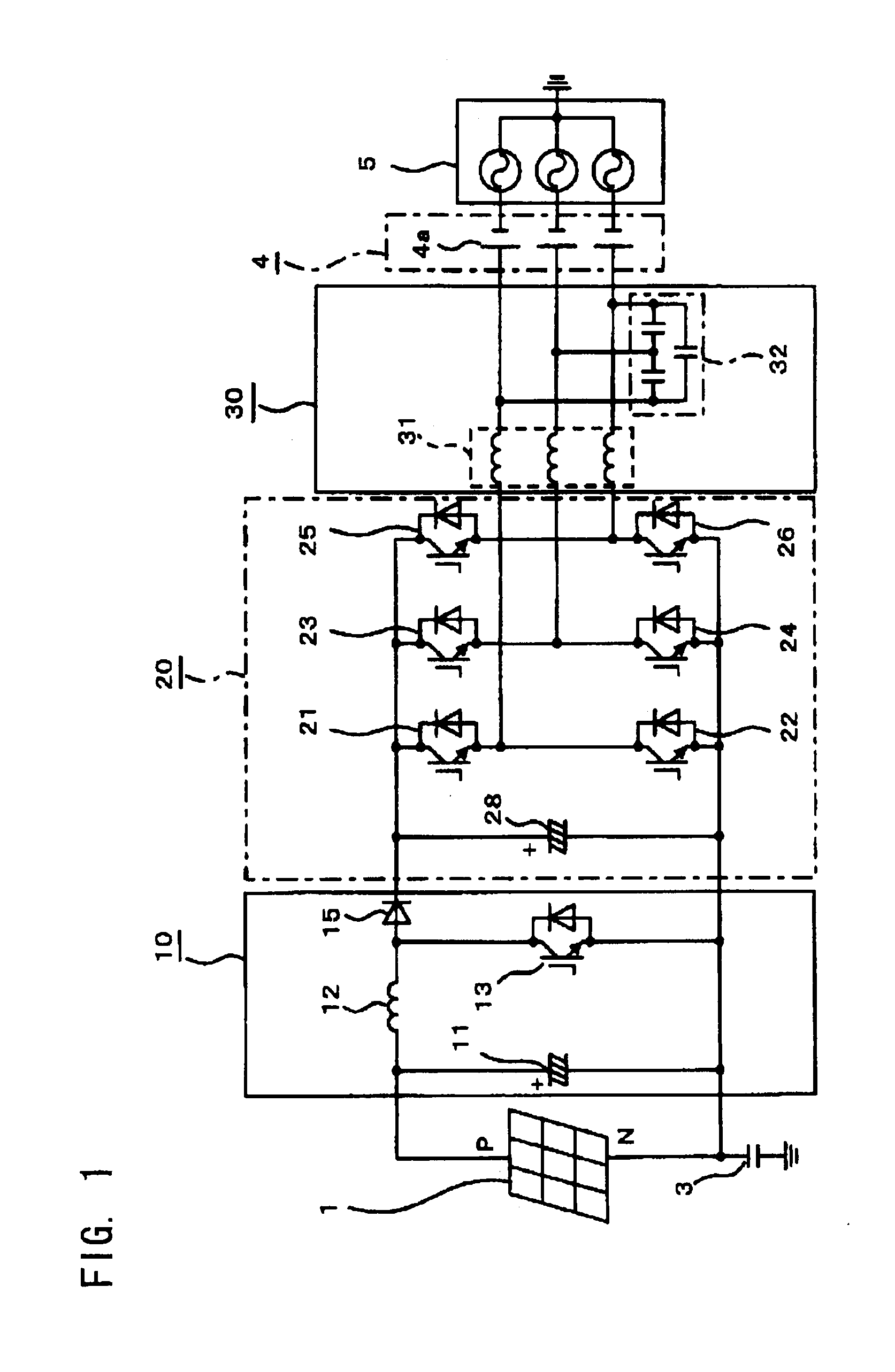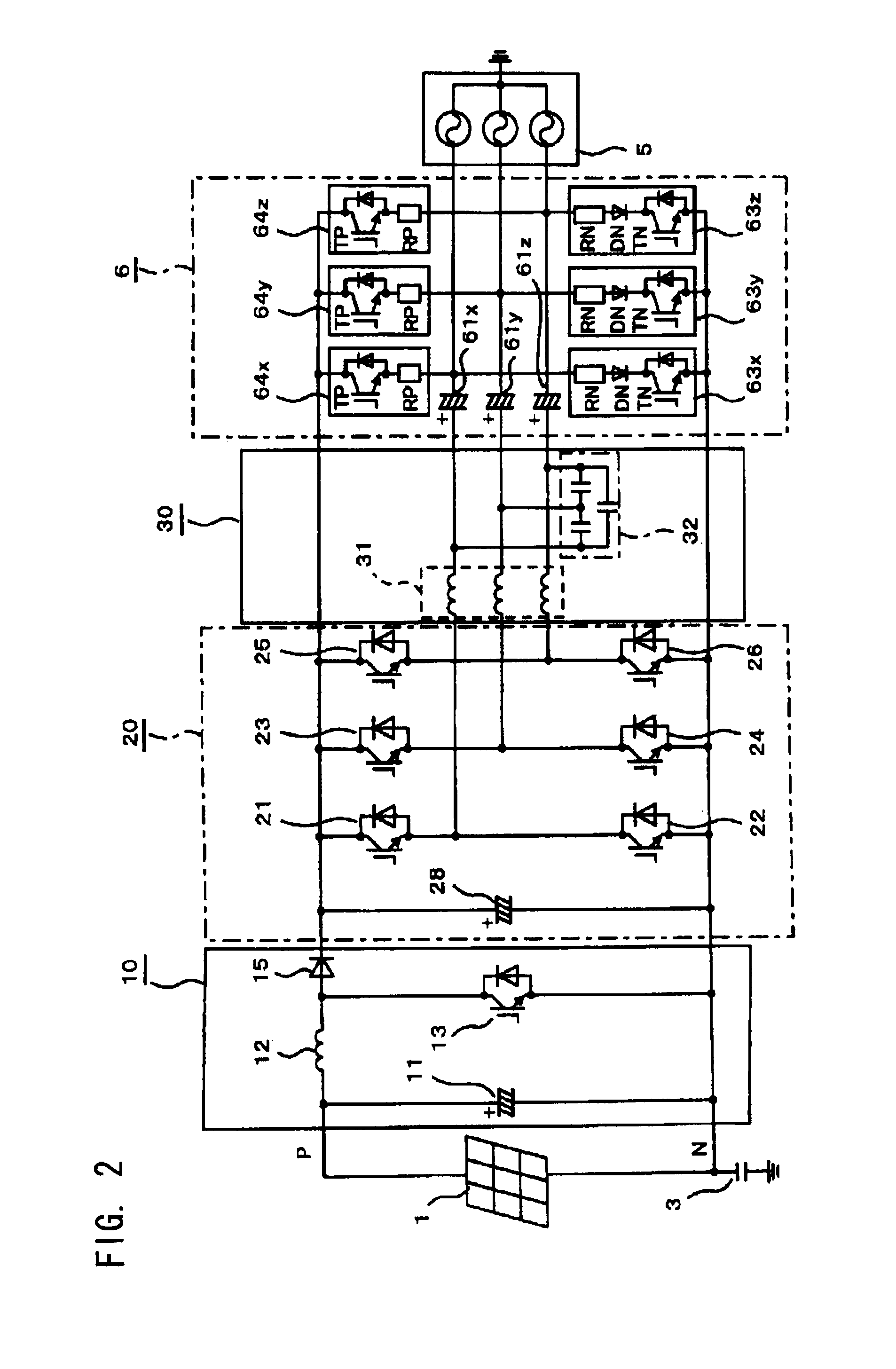Power conditioner for photovoltaic power generation
a photovoltaic power generation and power conditioner technology, applied in the direction of electric variable regulation, process and machine control, instruments, etc., can solve the problem that the grounding method of the negative electrode n is not applicable to non-isolated systems, and achieve the effect of reducing power loss and preventing the acceleration of the deterioration of the solar battery
- Summary
- Abstract
- Description
- Claims
- Application Information
AI Technical Summary
Benefits of technology
Problems solved by technology
Method used
Image
Examples
embodiment 1
[0024]FIG. 1 is a diagram showing the configuration of a power conditioner for photovoltaic power generation according to embodiment 1 of the present invention. With reference to FIG. 1, DC power generated by a solar battery 1 of thin-film type is converted (stepped up) into DC power having a DC voltage of 2 E (V) which is a predetermined voltage, by a step-up chopper circuit 10. The DC power that has been stepped up is converted into three-phase AC power by an inverter circuit 20 which is a power conversion apparatus. The three-phase AC power is sent to an AC power supply system 5 via a sine wave filter 30 and an output DC voltage circuit 4 which is a bias application apparatus. The solar battery 1 is not grounded, and a negative electrode N of the solar battery 1 is grounded via an equivalent capacitor 3 having a floating capacitance Cs between the negative electrode N and the ground. The AC power supply system 5 is a three-phase star-connection AC power supply system in which pow...
embodiment 2
[0030]FIGS. 2 and 3 show embodiment 2. FIG. 2 is a diagram showing the configuration of a power conditioner for photovoltaic power generation, and FIGS. 3 to 6 are circuit diagrams for one phase (X-phase) for explaining charge / discharge operation. Although in embodiment 1, the case where the batteries 4a are connected in series has been described, capacitors may be used instead of the batteries 4a. Charge / discharge circuits for controlling the DC voltages of the capacitors are needed for the capacitors. With reference to FIG. 2, an output DC voltage circuit 6 includes: output capacitors 61x to 61z in place of the batteries 4a shown in FIG. 1; and charge circuits 63x to 63z and discharge circuits 64x to 64z for the output capacitors 61x to 61z for the respective phases. The output capacitors 61x to 61z are provided, for the respective phases, between the AC power supply system 5 and the filter reactors 31 of the sine wave filter 30 connected to the AC output side of the inverter circ...
embodiment 3
[0037]FIG. 7 is a diagram showing the configuration of a power conditioner for photovoltaic power generation according to embodiment 3. With reference to FIG. 7, output capacitors 71x to 71z, whose impedances are set at 5% of the impedance of the AC power supply system 5, are provided, for the respective phases, between the AC power supply system 5 and the filter reactors 31 of the sine wave filter 30, such that the positive electrodes of the output capacitors 71x to 71z are connected to the filter reactors 31. The other components are the same as those of embodiment 2 shown in FIG. 2. Therefore, the other components are denoted by the same reference numerals as in embodiment 2, and the description thereof is omitted. Since output currents flow in the output capacitors 71x to 71z, the terminal voltages of the output capacitors 71x to 71z vary. In addition, in the case of three-phase AC, there are phase differences among the variations in the terminal voltages. Ideally, it is desired...
PUM
 Login to View More
Login to View More Abstract
Description
Claims
Application Information
 Login to View More
Login to View More - R&D
- Intellectual Property
- Life Sciences
- Materials
- Tech Scout
- Unparalleled Data Quality
- Higher Quality Content
- 60% Fewer Hallucinations
Browse by: Latest US Patents, China's latest patents, Technical Efficacy Thesaurus, Application Domain, Technology Topic, Popular Technical Reports.
© 2025 PatSnap. All rights reserved.Legal|Privacy policy|Modern Slavery Act Transparency Statement|Sitemap|About US| Contact US: help@patsnap.com



